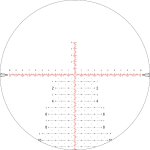I’m going to attempt to talk about PRS/competition style shooting, but I believe this carries over into other disciplines.
I’ve had this idea now for a while and I know I’m not the only one to have it. Why do we really need vertical stadia ( above the horizontal) in a reticle that is any taller than say one mil?
Why would it be such a bad thing to make it easier to see shot trace or increase visibility of your target field. Do we actually use those vertical marks past a certain point? I don’t...never have.
Do reticle designers feel like they are short changing us if they don’t throw that in there? A smart ass question for sure but hopefully somebody can enlighten me two why A large majority of us actually need that to be a part of a reticle.
Bring on your degrading and I’m smarter than you answers.
Thanks,
Mystified and patiently waiting
I’ve had this idea now for a while and I know I’m not the only one to have it. Why do we really need vertical stadia ( above the horizontal) in a reticle that is any taller than say one mil?
Why would it be such a bad thing to make it easier to see shot trace or increase visibility of your target field. Do we actually use those vertical marks past a certain point? I don’t...never have.
Do reticle designers feel like they are short changing us if they don’t throw that in there? A smart ass question for sure but hopefully somebody can enlighten me two why A large majority of us actually need that to be a part of a reticle.
Bring on your degrading and I’m smarter than you answers.
Thanks,
Mystified and patiently waiting


